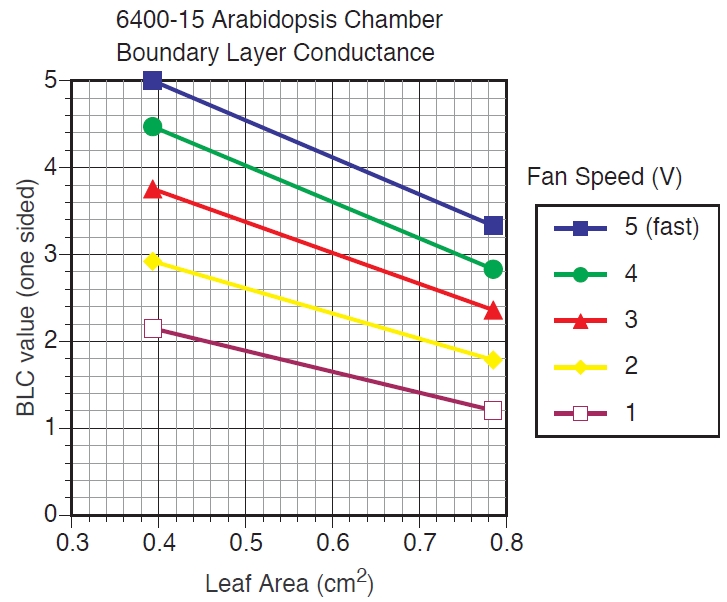Using the 6400-15 Arabidopsis Chamber
Installation instructions for the 6400-15 Arabidopsis Chamber, for use with the LI-6400/XT Portable Photosynthesis System.
This chamber has clear apertures for natural illumination of the top and bottom of the leaf. The apertures are 1.0 cm in diameter and are positioned 8.5 cm away from the main body of the IRGA. This design allows researchers to make measurements and access small leaves that are tightly bunched together. Until now these measurements were difficult, if not impossible to measure. The chamber apertures are covered with a clear Propafilm® window. These windows give excellent light transmission with very little thermal trapping and minimal water sorption. They are also easily replaceable and economically priced, so that properties can be maintained. Leaf temperature is computed using energy balance by thermocouple measurement of air exiting the chamber and radiation measurement with a standard quantum sensor.
The Arabidopsis chamber is made of plated aluminum which results in low water sorption and a more durable finish. The outside of the chamber is then painted with a very durable white paint for improved energy balance.
Although this chamber is designed specifically for Arabidopsis, it can also be used on other plants with small leaves. There are some limitations and precautions that must be considered when making measurements with this chamber, however:
- An important limitation of this chamber is shown in Figure 1‑1. The tall gasket and chamber wall (relative to the diameter of the aperture) makes it more likely that a significant portion of the leaf will be shaded. Notice the shadow cast over a portion of the aperture, caused by the source of illumination striking the chamber at an angle. This can cause serious measurement errors if care is not taken to orient the chamber so the light source is perpendicular to the aperture. The relatively tall gasket can also lead to greater non-uniformity of boundary layer conditions over the measured surface of the leaf; because of this, you should always use the High fan speed.
- Another important limitation of this chamber is the small leaf area encompassed by the chamber. This results in small differences in CO2 concentrations (deltas) between the sample and reference analyzers. As the deltas become smaller, photosynthesis measurements become more uncertain. To compensate for this, you will probably need to operate at lower flow rates, which can compound diffusion leaks through the gasket material.
- The larger gasket area to leaf area ratio means that greater attention must be made to diffusion leaks through the gasket material. As with any chamber or chamber material, any time there is a CO2 gradient between the inside and outside of the chamber, diffusion will occur through the gaskets, and will drive CO2 into or out of the chamber. Naturally, diffusion becomes more of a problem as the concentration in the cuvette diverges further from ambient. Therefore, when making A-Ci response curve measurements, greater care must be taken to account for leaks. The Using the LI-6400 instruction manual (Book 1), pages 4-43 to 4- 47, has a detailed discussion on diffusion leaks.
- The physical configuration of the chamber did not allow for placement of an internal leaf thermocouple or PAR sensor. A thermocouple is inserted in the chamber air stream, and temperatures measured here (along with information from an external quantum sensor) are used to compute foliage temperature using the energy balance approach used in LI-COR’s 6400-05 Conifer Chamber (see Operational Considerations below).
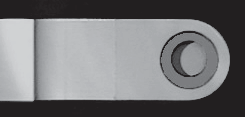
Although the 6400-15 can be used to measure other small leaves, it is a better practice to put the entire leaf in the LI-6400’s standard leaf chamber and use the 6400-02B Red/Blue light Source to provide uniform illumination of the leaf. This said, however, very good measurements can still be made with the 6400-15 Arabidopsis Chamber if the appropriate precautions are observed when setting up the experiment.
Installation Instructions
Follow the steps below to install the Arabidopsis Chamber, and read the operational considerations for information on configuring the LI-6400 software to compute leaf temperature using energy balance.
Removing the Standard Chamber
- The 6400-15 Arabidopsis chamber is mounted to the sensor head by removing the upper and lower halves of the standard leaf chamber. Unhook the PAR sensor connec- tor from the port on the side of the sensor head by gently pulling straight out. You will need to remove the tripod mounting bracket, if attached, to access the connector.
- Remove the upper half of the standard leaf chamber cuvette using the 3/32” hex key provided in the spare parts kit. The upper half of the leaf chamber is secured by two long screws that can be seen in front of the cuvette (Figure 2).
- Before installing the Arabidopsis chamber, transfer (or install new) air passage O-rings onto the upper leaf chamber cuvette. Lightly grease the O-rings with silicon lubricant.
- Remove the air hose from the underside of the leaf chamber.
- Unplug the leaf temperature thermocouple.
- Remove the two long screws from the lower half of the leaf chamber using the 3/32” hex key.
Installing the 6400-15
- Install the 6400-15 upper cuvette with two 4-40 × 1/2” screws included.
- Install the 6400-15 lower cuvette with the two 4-40 × 3/4” screws included. Make sure that the air passage O-rings are lightly greased and in place. The finished assembly will appear as shown below.
- Reattach the air hose to the underside of the 6400-15.
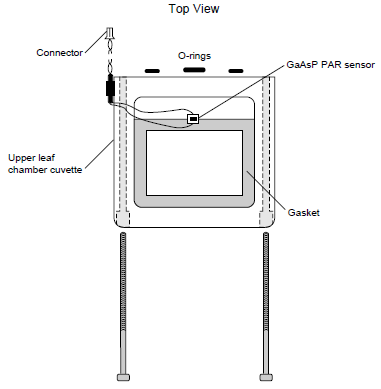
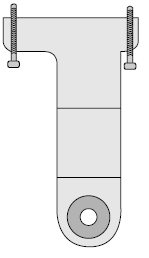
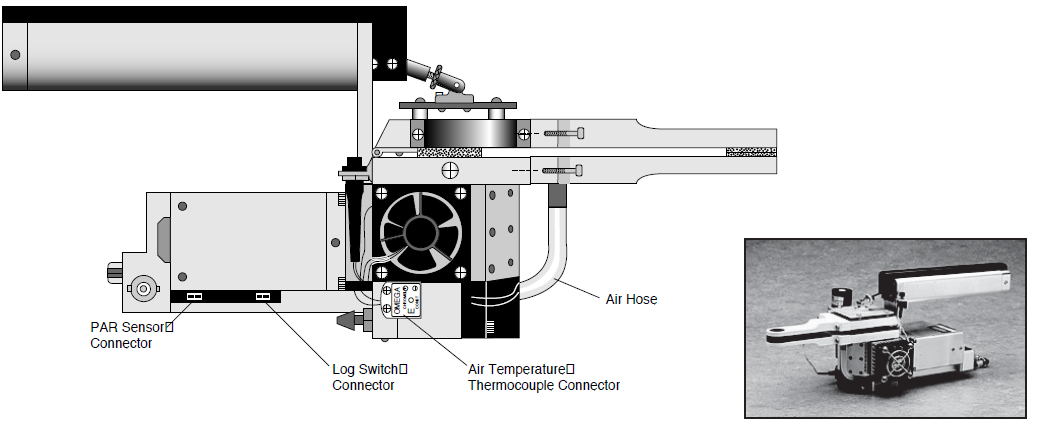
Software Considerations
Using the Arabidopsis chamber will require some configuration changes to the LI-6400:
- Leaf temperature must be computed with an energy balance, based on transpiration, air temperature, and a quantum sensor’s measure of incident radiation.
- The boundary layer conductance in this chamber is different than the standard chamber. OPEN 3.4 and above has a lookup table for this chamber, based on leaf area and fan speed. For earlier versions of software, you will have to enter a boundary layer conductance value by hand.
OPEN version 3.4 and above contains an entry in the installation menu to facilitate these changes. If you have an earlier version of software, you should start with the configuration for a 6400-06 Conifer Chamber, and modify it.
OPEN 3.4 and above
- Config Menu -> Installation Menu
- Select “6400-15 Arabidopsis Chamber”
- If more than one external quantum sensor has been installed on your system, you’ll be asked which one you want to use.
- You’ll be shown the configuration file. Press <escape> to go on.
- You are given an opportunity to store this configuration. The default name will be “Arabidopsis Chamber EB”, which you can modify as you wish.
OPEN 3.3 and below
- Config Menu -> Installation Menu
- Select “6400-06 Conifer Chamber”
- If more than one external quantum sensor has been installed on your system, you’ll be asked which one you want to use.
- When you are shown the configuration file, make the following changes:
- AREA=0.785
- BLCond= 3.4
- Press <escape> when done making the changes.
- Store the file, changing the name to something like “Arabidopsis Chamber”.
NOTE:' When using this configuration, you’ll have to adjust the BLCond value “by hand” if you change leaf area or fan speed. If the chamber aperture is covered, the area is 0.785 cm2. Examples: The BLCond value for this area, at a fan speed of high (5) is 3.4 (Figure 5). If you change the fan speed to 4, the BLC would be 2.8. If the fan speed is 5, and the aperture is about half covered (area = 0.4), the BLCond value is 5.0.
NOTE: As a practical matter, the difference between a BLCond of 3 and 5 is fairly small, especially at low stomatal conductances, so you may want to just leave the value at 3.4.
